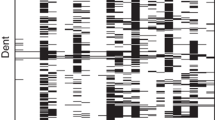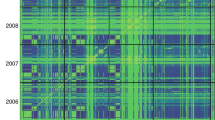Abstract
Selection of recombinant inbred lines (RILs) from elite hybrids is a key method in maize breeding especially in developing countries. The RILs are normally derived by repeated self-pollination and selection. In this study, we first investigated the accuracy of different models in predicting the performance of F1 hybrids between RILs derived from two elite maize inbred lines Zong3 and 87-1, and then compared these models through simulation using a wider range of genetic models. Results indicated that appropriate prediction models depended on genetic architecture, e.g., combined model using breeding value and genome-wide prediction (BV+GWP) has the highest prediction accuracy for high V D/V A ratio (>0.5) traits. Theoretical studies demonstrated that different components of genetic variance were captured by different prediction models, which in turn explained the accuracy of these models in predicting the F1 hybrid performance. Based on genome-wide prediction model (GWP), 114 untested F1 hybrids possibly having higher grain yield than the original F1 hybrid Yuyu22 (the single cross between Zong3 and 87-1) have been identified and recommended for further field test.




Similar content being viewed by others
References
Allard RW (1960) Principles of plant breeding. Wiley, New York 485 pp
Bernardo R (1994) Prediction of maize single-cross performance using RFLPs and information from related hybrids. Crop Sci 34:20–25
Bernardo R (1995) Genetic models for predicting maize single-cross performance inunbalanced yield trial data. Crop Sci 35:141–147
Bernardo R (1996a) Best linear unbiased prediction of maize single-cross performance. Crop Sci 36:50–56
Bernardo R (1996b) Best linear unbiased prediction of the performance of crosses between untested maize inbreds. Crop Sci 36:872–876
Bernardo R (1998) A model for marker-assisted selection among single crosses with multiple genetic markers. Theor Appl Genet 97:473–478
Bernardo R (1999) Marker-assisted best linear unbiased prediction of single-cross performance. Crop Sci 39:1277–1282
Bernardo R, Yu J (2007) Prospects for genomewide selection for quantitative traits in maize. Crop Sci 47:1082–1090
Charcosset A, Essioux L (1994) The effect of population structure on the relationship between heterosis and heterozygosity at marker loci. Theor Appl Genet 89:336–343
Cockerham CC (1967) Prediction of double crosses from single crosses. Der Züchter 37:160–169
Comstock RE, Robinson HF (1948) The components of genetic variance in populations. Biometrics 4:254–266
Comstock RE, Robinson HF (1952) Estimation of average dominance of genes. In: Gowen JW (ed) Heterosis. ISU Press, Ames, pp 494–516
De Los Campos G, Naya H, Gianola D, Crossa J, Legarra A, Manfredi E, Weigel K, Cotes JM (2009) Predicting quantitative traits with regression models for dense molecular markers and pedigree. Genetics 182:375–385
Frisch M, Thiemann A, Fu J, Schrag TA, Scholten S, Melchinger AE (2010) Transcriptome-based distance measures for grouping of germplasm and prediction of hybrid performance in maize. Theor Appl Genet 120:441–450
Gardner CO, Eberhart SA (1966) Analysis and interpretation of the variety cross diallel and related populations. Biometrics 22:439–452
Griffing B (1956a) Concept of general and specific combing ability in relation to diallel crossing systems. Aust J Biol Sci 9:463–493
Griffing B (1956b) A generalized treatment of the use of diallel crosses in quantitative inheritance. Heredity 10:31–50
Hallauer AR (1990) Methods used in developing maize inbreds. Maydica 35:1–16
Hallauer AR, Carena MJ, Filho JBM (2010) Quantitative genetics in maize breeding. Iowa State University Press, Ames
Hardy OJ, Vekemans X (2002) SPAGeDi: a versatile computer program to analyse spatial genetic structure at the individual or population levels. Mol Eco Notes 2:618–620
Henderson CR (1975) Best linear unbiased estimation and prediction under a selection model. Biometrics 31:423–447
Henderson CR (1984) Applications of linear models in animal breeding. University of Guelph, Guelph
Hua J, Xing Y, Wu W, Xu C, Sun X, Yu S, Zhang Q (2003) Single-locus heterotic effects and dominance by dominance interactions can adequately explain the genetic basis of heterosis in an elite rice hybrid. Proc Nat Acad Sci 100:2574–2579
Jenkins MT (1934) Methods of estimating the performance of double crosses in corn. J Am Soc Agron 26:199–204
Jordan DR, Tao Y, Godwin ID, Henzell RG, Cooper M, McIntyre CL (2003) Prediction of hybrid performance in grain sorghum using RFLP markers. Theor Appl Genet 106:559–567
Kearsey MJ, Jinks JL (1968) A general method of detecting additive, dominance and epistatic variation for metrical traits. I: theory. Heredity 23:403–409
Lai J, Li R, Xu X, Jin W, Xu M, Zhao H, Xiang Z, Song W, Ying K, Zhang M, Jiao Y, Ni P, Zhang J et al (2010) Genome-wide patterns of genetic variation among elite maize inbred lines. Nat Genet 42:1027–1030
Li Y, Wang T (2010) Germplasm base of maize breeding in China and formation of key parents in maize breeding in China (in Chinese with English abstract). J Maize Sci 18(5):1–8
Li H, Ye G, Wang J (2007) A modified algorithm for the improvement of composite interval mapping. Genetics 175:361–374
Lorenzana RE, Bernardo R (2009) Accuracy of genotypic value predictions for marker-based selection in biparental plant populations. Theor Appl Genet 120:151–161
Maenhout S, Baets BD, Haesaert G (2010) Prediction of maize single-cross hybrid performance: support vector machine regression versus best linear prediction. Theor Appl Genet 120:415–427
Melchinger AE (1999) Genetic diversity and heterosis. In: Coors JG, Pandey S (eds) The genetics and exploitation of heterosis in crops. ASA-CSSA, Madison, pp 99–118
Melchinger AE, Geiger HH, Seitz G, Schmidt GA (1987) Optimum prediction of three-way crosses from single crosses in forage maize (Zea mays L.). Theor Appl Genet 74:339–345
Meuwissen THE, Hayes BJ, Goddard ME (2001) Prediction of total genetic value using genome-wide dense marker maps. Genetics 157:1819–1829
Quaas RL, Pollak EJ (1980) Modified equations for sire models with groups. J Dairy Sci 54:1868–1872
Schrag TA, Melchinger AE, Sørensen AP, Frisch M (2006) Prediction of single-cross hybrid performance for grain yield and grain dry matter content in maize using AFLP markers associated with QTL. Theor Appl Genet 113:1037–1047
Smith OS (1986) Covariance between line per se and testcross performance. Crop Sci 26:540–543
Tang J, Yan J, Ma X, Teng W, Wu W, Dai J, Dhillon BS, Melchinger AE, Li J (2010) Dissection of the genetic basis of heterosis in an elite maize hybrid by QTL mapping in an immortalized F2 population. Theor Appl Genet 120:333–340
Teng W, Cao J, Chen Y, Liu X, Jing X, Zhang F, Li J (2004) Analysis of maize heterotic groups and patterns during past decade in China (in Chinese with English abstract). Scienta Agricultura Sinica 37(12):1804–1811
Vuylsteke M, Kuiper M, Stam P (2000) Chromosomal regions involved in hybrid performance and heterosis: their AFLP (R)-based identification and practical use in prediction models. Heredity 85:208–218
Wang J, van Ginkel M, Podlich D, Ye G, Trethowan R, Pfeiffer W, DeLacy IH, Cooper M, Rajaram S (2003) Comparison of two breeding strategies by computer simulation. Crop Sci 43:1764–1773
Wang J, van Ginkel M, Trethowan R, Ye G, Delacy I, Podlich D, Cooper M (2004) Simulating the effects of dominance and epistasis on selection response in the CIMMYT Wheat Breeding Program using QuCim. Crop Sci 44:2006–2018
Yu Y, Wang R, Shi Y, Song Y, Wang T, Li Y (2007) Genetic diversity and structure of the core collection for maize lines in China. Maydica 52:181–194
Zaidi PH, Srinivasan G, Sanchez C (2003) Relationship between line per se and cross performance under low nitrogen fertility in tropical maize (Zea mays L.). Maydica 48:221–231
Zhang L, Li H, Li Z, Wang J (2008) Interactions between markers can be caused by the dominance effect of quantitative trait loci. Genetics 180:1177–1190
Acknowledgments
This research was supported by National Hi-Tech Research and Development Program of China (2012AA101104-1). We thank Professor Rex Bernardo, Department of Agronomy and Plant Genetics, University of Minnesota for his constructive comments and suggestions to previous versions of this paper.
Author information
Authors and Affiliations
Corresponding author
Additional information
Communicated by M. Frisch.
Electronic supplementary material
Below is the link to the electronic supplementary material.
Rights and permissions
About this article
Cite this article
Guo, T., Li, H., Yan, J. et al. Performance prediction of F1 hybrids between recombinant inbred lines derived from two elite maize inbred lines. Theor Appl Genet 126, 189–201 (2013). https://doi.org/10.1007/s00122-012-1973-9
Received:
Accepted:
Published:
Issue Date:
DOI: https://doi.org/10.1007/s00122-012-1973-9




